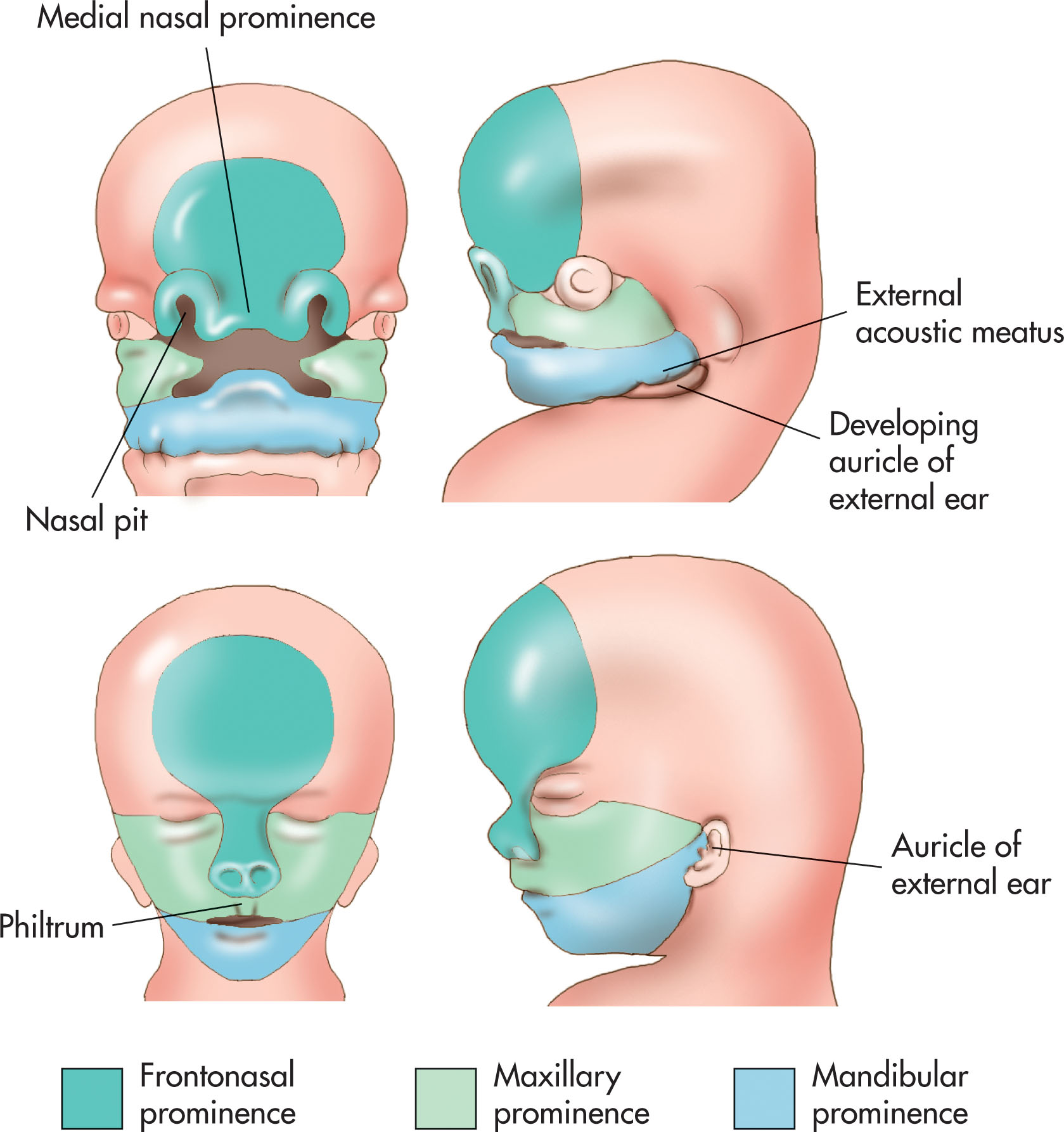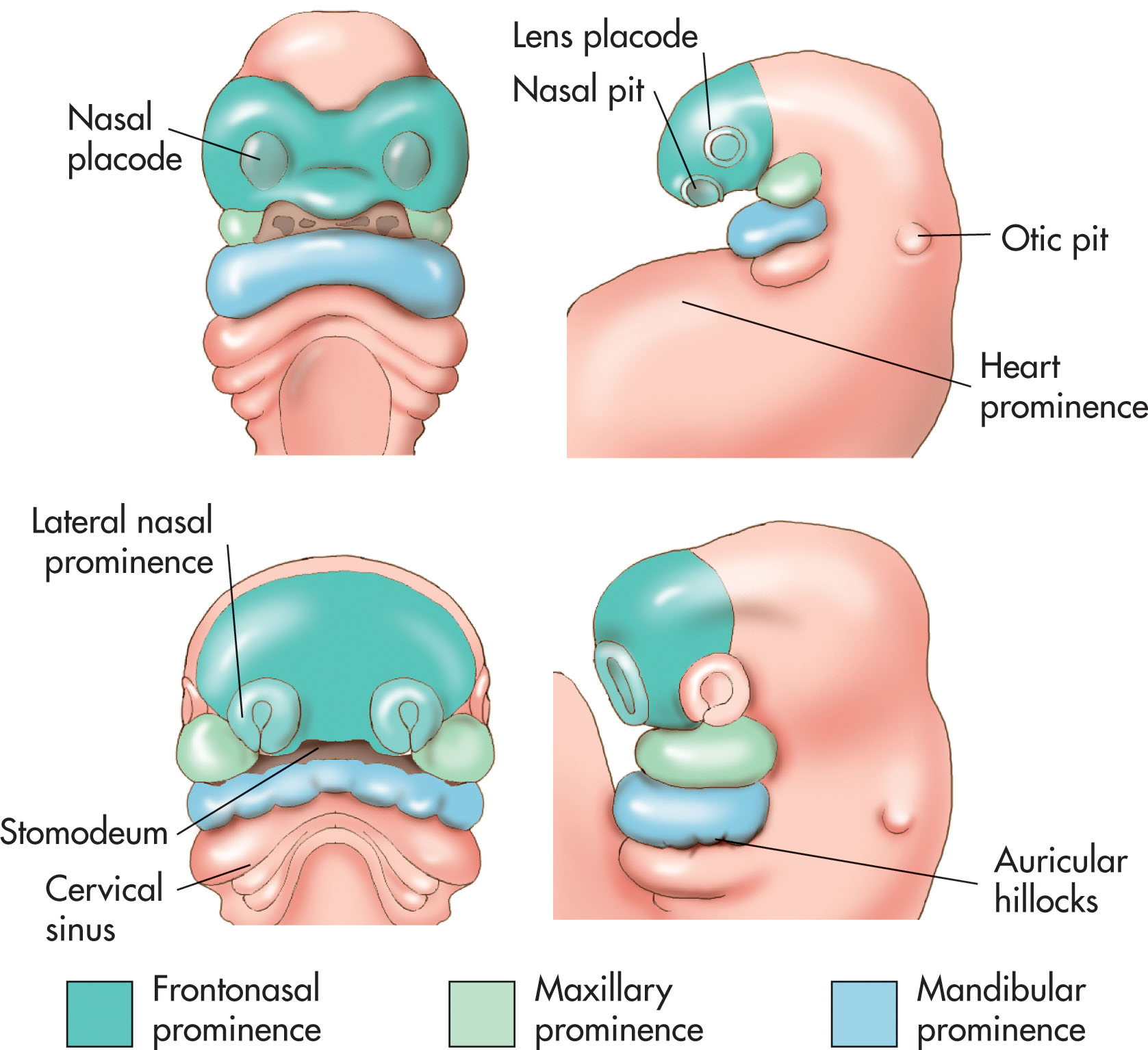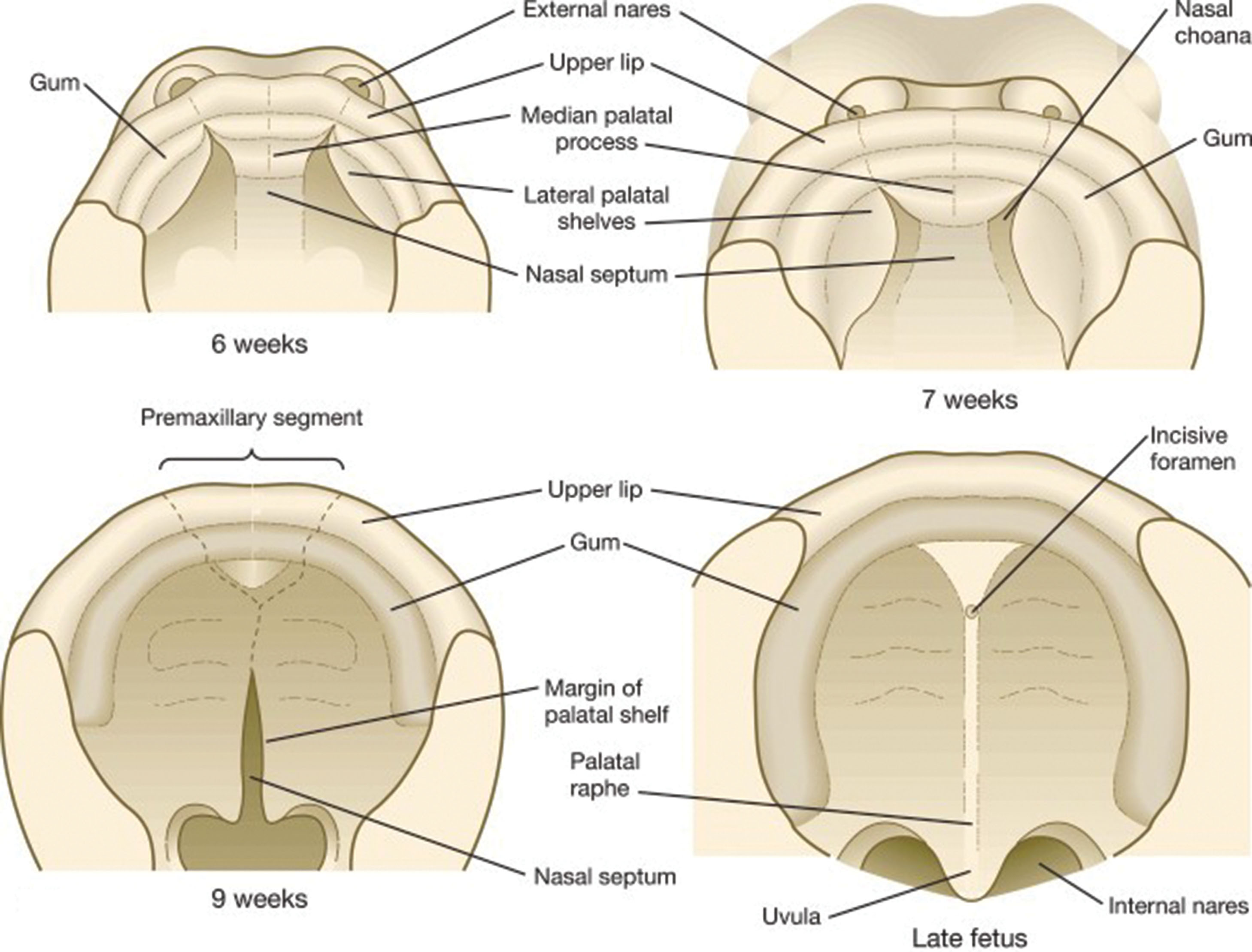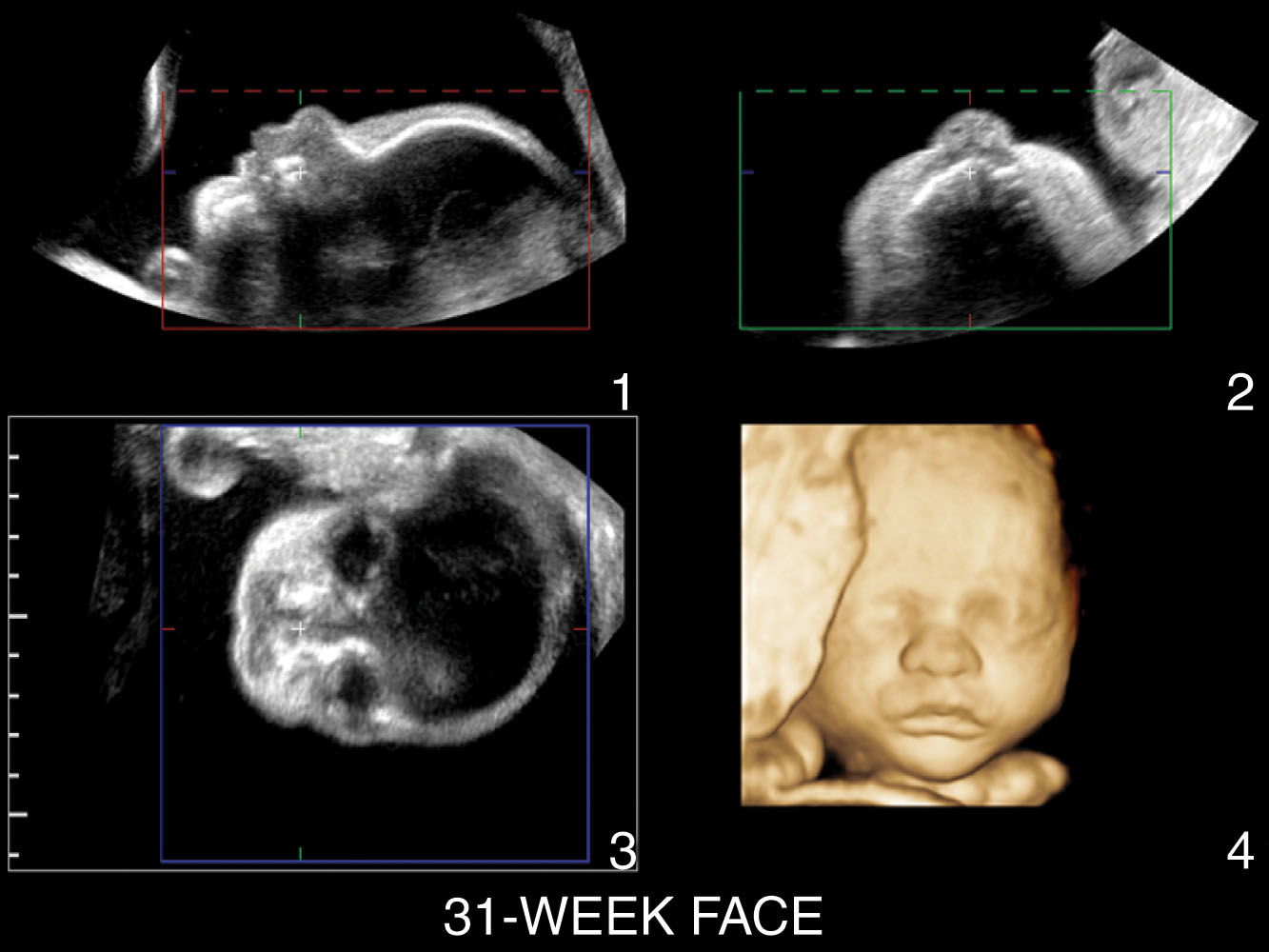Physical Address
304 North Cardinal St.
Dorchester Center, MA 02124
On completion of this chapter, you should be able to:
Discuss basic embryology of the face
Describe how to sonographically evaluate the fetal face and neck for normal features
Define the most common face and neck congenital anomalies discovered sonographically in utero
Embryological development is often arduous and complex, with facial feature embryogenesis being no exception. The evolution happens early in development, occurring between weeks 4 to 10, and necessitates the coordination and timing of various tissues in order to reach each person’s unique facial features. The World Health Organization (WHO) reports approximately 20% of surviving infants with congenital facial disparities have other associated anomalies, with the statistic much higher among stillborn infants.
The WHO also reports congenital anomalies of the face to affect 1 in 500 to 700 births; however, this comes with a wide variance across ethnic, socioeconomic, and geographic groupings. Orofacial clefts have long been recognized as one of the most common facial malformations, and with the assistance of sonographic evaluation, are often discovered prior to delivery. Affecting 1 in every 940 births, an oral cleft abnormality is the most common of these congenital facial anomalies and represents the second most common congenital disability in the United States. However, the highest proportion is seen among Asian populations.
As is the case with sonography in general, the detection of subtle facial malformations can depend on the investigator’s skill set and ability to thoroughly perform a complete study. Given the nature of sonographic imaging, many detrimental factors may inhibit a thorough and accurate examination of the fetal face, including the position of the fetus, maternal body habitus, presence of uterine pathology, and even the amount of amniotic fluid present. Any facial abnormality should immediately incite clinicians to meticulously search for other defects, as they often occur as signposts of syndromes. This chapter discusses the overall concept of embryological development of the facial features and examines some of the more commonly encountered craniofacial and fetal neck pathologies discovered with sonographic evaluation.
During the fourth and fifth weeks, the embryo has characteristic external features of the head and neck area in the form of a series of branchial arches, pouches, grooves, and membranes. Their development and evolution require a very precise and complex process with defined and orderly expectations throughout the fetal stage of formation. These structures, referred to as the branchial apparatus , bear a resemblance to gills and necessitate all three primary embryonic tissues of the endoderm, mesoderm, and ectoderm working together in sequence to avoid potential disfiguring and devastating facial malformations. The broad spectrum of congenital facial anomalies ranges from cosmetic indiscretions such as cleft lips to potentially life-threatening malformations such as arrhinia and obstructive oropharyngeal teratomas and their sequelae.
There are six branchial arches, but only the first four are visible externally ( Fig. 59.1A ). Neural crest cells migrate into the branchial arches and proliferate, resulting in swelling that demarcates each arch. The neural crest cells develop the skeletal features of the face, and the mesoderm of each arch develops the musculature of the face and neck. The arches are separated by branchial grooves, and each is composed of a core of mesenchymal cells and tissues derived from intraembryonic mesoderm covered by ectoderm. The mesenchyme forms the cartilage, bone, muscle, and blood vessels.

The fusion of five facial prominences must occur to form the lips and nose: frontonasal prominence, a pair of maxillary prominences, and a pair of mandibular prominences. Aberrant anatomical variations affecting the face may occur due to defects involving any of the branchial arches. The first branchial arch develops into the maxillary and mandibular arches, forming the jaw, zygomatic bone, ear, and temporal bone (see Fig. 59.1B ). The maxillary prominences arise and grow cranially just inferior to the eyes, and the mandibular prominence grows inferiorly, forming the mandible and squamous components of the temporal bones. The second branchial arch contributes to the hyoid bone. The severity and magnitude of congenital abnormalities of the first and second branchial arches will depend on the extent of the insult, with timing playing a crucial component of its scope, often relating to hypoplasia or even aplasia of these anatomical variations.
The complex formation of the facial lips is composed of multiple prominences growing steadily together, with the correct timing being essential to completing the process correctly. The maxillary prominences grow medially between the fifth and eighth weeks, with this growth compressing the medial nasal prominences together towards the midline. The two medial nasal prominences and the two maxillary prominences lateral to them fuse together to form the upper lip ( Fig. 59.2 ). The medial nasal prominences form the medial aspect of the lip, which is the origin of the labial component of the lip, the upper incisor teeth, and the anterior aspect of the primary palate. The lateral nasal prominences form the alae of the nose. The maxillary prominences and lateral nasal prominences are separated by the nasolacrimal groove, where the nasolacrimal duct and lacrimal sac reside. The mandibular prominences merge at the end of the fourth to fifth week and form the lower lip and jaw, chin, and mandible.

The nose is formed in three parts. The nasal pits are formed as the surface ectoderm thickens into the nasal placodes on each side of the frontal nasal prominence; these placodes then invaginate on either side ( Fig. 59.3 ). The bridge of the nose originates from the frontal prominence, the two medial nasal prominences form the crest and tip of the nose, and the lateral nasal prominences form the sides, or alae. The maxillary prominences then fuse with the nasal prominences and soon after fuse in the midline to form a continuous central structure.

The primitive mouth is an indentation on the surface of the ectoderm (referred to as the stomodeum ) (see Fig. 59.2 ). Until 24 to 26 days of gestation, the stomodeum is separated from the pharynx by a membrane that ruptures to place the primitive gut in communication with the amniotic cavity. At approximately the same time, five prominences are identified: the frontal nasal prominence, forming the upper boundary of the stomodeum; the paired maxillary prominences of the first branchial arch, forming the lateral boundaries of the stomodeum; and the paired mandibular prominences, forming the caudal boundary. As these prominences fuse together in the midline, the mouth continues to be separated from the nasal cavity by the palate ( Fig. 59.4 ).

The palate forms the roof of the mouth and the floor of the nasal cavity and is divided into the hard palate, located more anteriorly, and the soft palate, which is located more posteriorly. The primary palate begins forming early in the sixth week, with the wedge-shaped mass created by the emergence of the medial nasal prominences between the developing maxillae. As the nose forms, the fusion of the medial nasal prominence with its contralateral counterpart creates the primary palate (becomes the anterior one-third of the definitive palate). The primary palate forms the anterior and midline aspect of the maxilla, which represents a small part of the adult hard palate ( Fig. 59.5 ).

The intermaxillary segment also contributes to the labial component of the philtrum and the upper four incisors. The maxillary prominences expand medially to give rise to the palatal shelves, which continue to advance medially, fusing superior to the tongue. Simultaneously, the developing mandible expands to increase the size of the oral cavity; this allows the tongue to drop out of the way of the growing palatal shelves. The palatal shelves then fuse with each other in the horizontal plane and the nasal septum in the vertical plane, forming the secondary palate. The face and palate complete midline fusion between the sixth and twelfth weeks of gestation.
Human ear development is complex and lengthy, commencing around week 4 and extending well beyond the neonatal period into puberty, when the glands of the external canal become fully functional. However, for purposes of sonographic evaluation, the pinna, or external ear, embryogenesis is the most relevant for a thorough understanding of external ear development disorders. Around the fifth week, the vestigial gills on each lateral side, external to the fetal cranium, begin widening as the start of the development of the external auditory canal. Around this opening, six tissue thickenings, called hillocks, arise from the branchial arches I and II to fuse and form the basic units of the pinna. The first and second pharyngeal arch apparatus lends the structural foundation for formation of the external ear. By approximately the 20th week, the auricular hillocks enlarge asymmetrically and ultimately coalesce to form a recognizable external ear. They then migrate superiorly to the adult location and overall configuration.
Given the often-fearful reaction that fetal anomalies in general and especially facial anomalies can carry due to their negative social and psychological impacts, sonographic facial evaluation must be closely scrutinized. Evaluations should be routinely included in all fetal anatomic surveillance studies and with increased analysis when there is a family history of craniofacial malformation or when another congenital anomaly is discovered due to the close association of facial abnormalities with coexisting fetal malformations. Typically, the sonographic evaluation consists of utilizing all three orthogonal imaging planes (sagittal, axial, and coronal), as each provides a unique perspective of the three dimensions of organs; however, with the advent of three- and four-dimensional imaging, specific information beyond these planes can often be obtained ( Fig. 59.6 ).

Facial anomalies are heterogeneous and can occur as isolated defects or as part of a larger setting (with global anomalies), as a condition, or as part of a larger syndrome (e.g., orbital fusion and a proboscis suggest alobar holoprosencephaly). Often a fetus with congenital facial deformations discovered prenatally will require a multidisciplinary team approach consisting of obstetricians, geneticists, sonographers, pediatricians, radiologists, surgeons, and specific specialty domains. As sonography has become the imaging gold standard in prenatal screening and plays a crucial role in the evaluation and with serial assessments, imaging results necessitate a high level of accuracy to provide precise and correct information regarding diagnosis and potential prognosis to the parents ( Box 59.1 ). The use of three-dimensional ultrasound (3DUS) and four-dimensional ultrasound (4DUS) reconstruction has been shown in recent years to be a useful adjunct to conventional two-dimensional (2D) or bidirectional screening assessment of the fetal face.
Features of the fetal face can be identified at the end of the first trimester.
The fetal profile is well imaged with transvaginal sonography beginning late first trimester to early second trimester (make sure adequate amniotic fluid surrounds the face) (see Fig. 59.5 ).
The modified coronal view is best for imaging the cleft lip and palate (see Fig. 59.6 ).
The maxilla and orbits are well imaged in a true coronal plane.
The lens of the eye is seen as a small echogenic circle within the orbit (see Fig. 59.7 ).
The longitudinal view demonstrates the nasal bones, soft tissue, and mandible (useful to rule out micrognathia, anterior encephalocele, or nasal bridge defects; examine upper lip) (see Fig. 59.8 ).
Transverse view shows orbital abnormalities and intraorbital distances (useful to evaluate the maxilla, mandible, and tongue).
Worldwide, craniofacial anomalies are a concern for infant mortality and pediatric morbidity. A family history of craniofacial malformations may prompt a targeted sonographic study along with specific genetic testing in an attempt to identify associated risk factors. When available, a geneticist should complete a thorough history, often of three-generation pedigrees, in an attempt to better understand how the craniofacial malformation happened and determine the risk for future pregnancies and generations. In addition, this exercise should better determine if identified anomalies are isolated or part of a larger genetic syndrome.
Dysmorphology, or the study of human congenital malformations and syndromes, divides congenital anomalies into three classifications of alterations that occur to typical morphology. A malformation sequence , or the process of poor formation of tissue, allows for a chain reaction of defects to occur as normal tissue is not a foundation. A deformation sequence gives way to normal tissue development; however, external factors contribute to secondary distortion or deformation. These may occur in a variety of ways, and their scope of effect may be slight to profound, affecting normal tissue growth with exacerbated anatomical variations. Finally, a disruption sequence occurs when embryogenesis is disrupted by tissue breakdown or injury from a possible broad spectrum of opportunities, including infectious, mechanical, vascular, or metabolic origin. To complicate the comprehension of congenital anomalies, a fetal anomaly can often only be explained by the combination of sequential defects happening in utero.
Craniofacial malformations constitute a spectrum of anomalies, including clefting of the face, lip, and palates; craniosynostosis ; nasal deviations; tongue sizes and masses; mandibular variations that affect the chin; microtia or ear irregularities; orbital architecture disparities; and many other well-described craniofacial pathologies. Because orofacial anomalies can be isolated events or inclusive of a larger setting of a more severe syndrome, recurrence rates vary. Knowing as much information as possible will better allow the family to understand how future pregnancies may be affected and allow for the current pregnancy to be accurately monitored for possible progression of anomalies and their effects ( Boxes 59.2 and 59.3 ).
Are the orbits normally spaced?
Are the nose and nasal bridge clearly imaged; is a proboscis or cebocephaly present?
Are any periorbital masses apparent?
Is the upper lip intact?
Is the tongue normal size?
Is the chin abnormally small?
Are the ears of normal size and in normal position?
Use midsagittal scans through the face to assess the following:
Curvilinear surface with differentiation of forehead, nose, lips, and chin
Cloverleaf skull: appears as misshapened skull with cloverleaf appearance
Frontal bossing: may appear as lemon-shaped skull or absent, depressed nasal bridge
Strawberry-shaped cranium: bulging of frontal bones and wide occiput
Masses of nose and upper lip: distortion of facial profile (look for cleft lip)
Become a Clinical Tree membership for Full access and enjoy Unlimited articles
If you are a member. Log in here